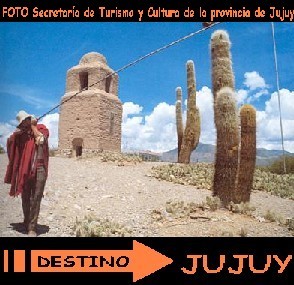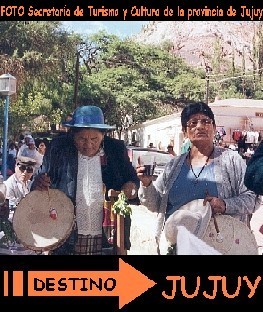Música Regional
Es posible que en su recorrido por el NOA el viajero tenga ocasión de escuchar algo de su música folclórica, ya sea en alguna peña de la ciudad, a través de la radio o en un caserío perdido en la Puna, donde se celebra una fiesta. El hombre de los llanos, las alturas o los valles canta, según Atahualpa Yupanqui, “lo que la tierra le dicta”.
En el NOA se pueden distinguir dos territorios musicales: el del Altiplano, entroncado con la tradición musical andina y el de los valles, llanos y desiertos que junto con las influencias andinas, le debe a la música española ciertos ritmos y fundamentalmente la incorporación de la guitarra entre sus instrumentos.
Mientras la música del Altiplano – basada en una escala de cinco tonos e interpretada con una serie de instrumentos autóctonos puede considerarse como propiamente indígena, la música de los llanos (y la que el viajero puede escuchar en las peñas ciudadanas) representa el tronco más vital del folklore Argentino.
Las canciones características del NOA son las “vidalas” y “vidalitas”, además de la “baguala” (del quechua wawalla o wawllay, “aullar”). Este lastimoso canto está basado en apenas tres notas que el bagualero improvisa acompañándose con golpes de caja. Es originario de los valles calchaquíes y una de las pocas expresiones folclóricas argentinas que carece de influencias hispánicas.
Instrumentos Autóctonos
CHARANGO: es uno de los instrumentos de cuerda más utilizados en la región. La caja es de caparazón de quirquincho y cuenta con 4 o 5 cuerdas que se templan con los dedos.
ERKE: instrumento de viento de origen quechua que mide entre 3 y 7 mts de largo. Consta de varios trozos de caña ahuecados. Es usado especialmente durante la celebración de Corpus Christi en Salta y la Quebrada de Humahuaca.
CAJA: es un tambor de forma cilíndrica que los indígenas construyen con un tronco de árbol ahuecado y cuyos extremos cubren con cueros de cabra curtidos.
QUENA: flauta sin embocadura, de cinco agujeros delanteros y uno posterior. En la actualidad, lo más común es que sean de caña, pero primitivamente los indígenas las construían con tibias, madera dura o tierra cocida. Produce un sonido melancólico similar al llanto.
BOMBO: tambor realizado en una sola pieza de madera de ceibo ahuecado, base rítmica por excelencia del folklore argentino.

Regional Music
While journeying in the region, the traveller may have the chance to listen to folk music, either in a “peña” in the city, on the radio, or in some hamlet out on the Puna during a feast.
According to Atahualpa Yupanqui, a folk singer, the man living on the plains, the mountains or in the valleys, sings, “What the earth tells him”.
There are two types of music in the Northwest. The music of the Altiplano, which belongs to the Andean musical tradition, and that of the valleys, plains and deserts, that has Andean influence, but owes Spanish music some of its rhythms and, most important of all, the introduction of the guitar.
While the music of the altiplano – which has a scale of 5 notes and is played on a series of native instruments- can be considered completely indigenous, the music of the plains (and that which can be heard in the city peñas, for example) is the backbone of Argentine folklore.
The traditional songs of the northwest are the “vidalas” and the “vidalitas”, as well as the “baguala” (from the quechua wawalla or wawllay, “to howl”. This sad lament consists of only three notes, which the bagualero (herdsman) improvises, to the accompaniment of a caja. The song originated in the Calchaquí valleys and is one of the few elements of Argentine folklore that lacks Spanish influence.

Native Instruments
CHARANGO: the most commonly used string instrument in the region. The body is made with the shell of a quirquincho (armadillo), and it has 5 strings, which are plucked by the fingers.
ERKE: a wind instrument of Quechua origin, measuring between 3 and 7 mts in length. It is made up of various pieces of hollowed out cane, and is used especially during the feast of Corpus Christi in Salta and the Quebrada de Humahuaca.
CAJA: this is a cylindrical drum, which the natives make out of the hollowed out section of a tree trunk, covering the ends with tanned goat skins.
QUENA: a flute without a mouthpiece, with 5 holes in front and one behind. It is made out of cane, but originally the tibia of an animal, hard wood or terra cotta was used. It has a melancholy, weeping sound.
BOMBO: a drum made from one piece of hollowed out ceibo wood, which is the base rhythm of Argentine folklore music.
Es posible que en su recorrido por el NOA el viajero tenga ocasión de escuchar algo de su música folclórica, ya sea en alguna peña de la ciudad, a través de la radio o en un caserío perdido en la Puna, donde se celebra una fiesta. El hombre de los llanos, las alturas o los valles canta, según Atahualpa Yupanqui, “lo que la tierra le dicta”.
En el NOA se pueden distinguir dos territorios musicales: el del Altiplano, entroncado con la tradición musical andina y el de los valles, llanos y desiertos que junto con las influencias andinas, le debe a la música española ciertos ritmos y fundamentalmente la incorporación de la guitarra entre sus instrumentos.
Mientras la música del Altiplano – basada en una escala de cinco tonos e interpretada con una serie de instrumentos autóctonos puede considerarse como propiamente indígena, la música de los llanos (y la que el viajero puede escuchar en las peñas ciudadanas) representa el tronco más vital del folklore Argentino.
Las canciones características del NOA son las “vidalas” y “vidalitas”, además de la “baguala” (del quechua wawalla o wawllay, “aullar”). Este lastimoso canto está basado en apenas tres notas que el bagualero improvisa acompañándose con golpes de caja. Es originario de los valles calchaquíes y una de las pocas expresiones folclóricas argentinas que carece de influencias hispánicas.
Instrumentos Autóctonos
CHARANGO: es uno de los instrumentos de cuerda más utilizados en la región. La caja es de caparazón de quirquincho y cuenta con 4 o 5 cuerdas que se templan con los dedos.
ERKE: instrumento de viento de origen quechua que mide entre 3 y 7 mts de largo. Consta de varios trozos de caña ahuecados. Es usado especialmente durante la celebración de Corpus Christi en Salta y la Quebrada de Humahuaca.
CAJA: es un tambor de forma cilíndrica que los indígenas construyen con un tronco de árbol ahuecado y cuyos extremos cubren con cueros de cabra curtidos.
QUENA: flauta sin embocadura, de cinco agujeros delanteros y uno posterior. En la actualidad, lo más común es que sean de caña, pero primitivamente los indígenas las construían con tibias, madera dura o tierra cocida. Produce un sonido melancólico similar al llanto.
BOMBO: tambor realizado en una sola pieza de madera de ceibo ahuecado, base rítmica por excelencia del folklore argentino.

Regional Music
While journeying in the region, the traveller may have the chance to listen to folk music, either in a “peña” in the city, on the radio, or in some hamlet out on the Puna during a feast.
According to Atahualpa Yupanqui, a folk singer, the man living on the plains, the mountains or in the valleys, sings, “What the earth tells him”.
There are two types of music in the Northwest. The music of the Altiplano, which belongs to the Andean musical tradition, and that of the valleys, plains and deserts, that has Andean influence, but owes Spanish music some of its rhythms and, most important of all, the introduction of the guitar.
While the music of the altiplano – which has a scale of 5 notes and is played on a series of native instruments- can be considered completely indigenous, the music of the plains (and that which can be heard in the city peñas, for example) is the backbone of Argentine folklore.
The traditional songs of the northwest are the “vidalas” and the “vidalitas”, as well as the “baguala” (from the quechua wawalla or wawllay, “to howl”. This sad lament consists of only three notes, which the bagualero (herdsman) improvises, to the accompaniment of a caja. The song originated in the Calchaquí valleys and is one of the few elements of Argentine folklore that lacks Spanish influence.

Native Instruments
CHARANGO: the most commonly used string instrument in the region. The body is made with the shell of a quirquincho (armadillo), and it has 5 strings, which are plucked by the fingers.
ERKE: a wind instrument of Quechua origin, measuring between 3 and 7 mts in length. It is made up of various pieces of hollowed out cane, and is used especially during the feast of Corpus Christi in Salta and the Quebrada de Humahuaca.
CAJA: this is a cylindrical drum, which the natives make out of the hollowed out section of a tree trunk, covering the ends with tanned goat skins.
QUENA: a flute without a mouthpiece, with 5 holes in front and one behind. It is made out of cane, but originally the tibia of an animal, hard wood or terra cotta was used. It has a melancholy, weeping sound.
BOMBO: a drum made from one piece of hollowed out ceibo wood, which is the base rhythm of Argentine folklore music.

0 Comentarios:
Publicar un comentario
Suscribirse a Comentarios de la entrada [Atom]
<< Página Principal